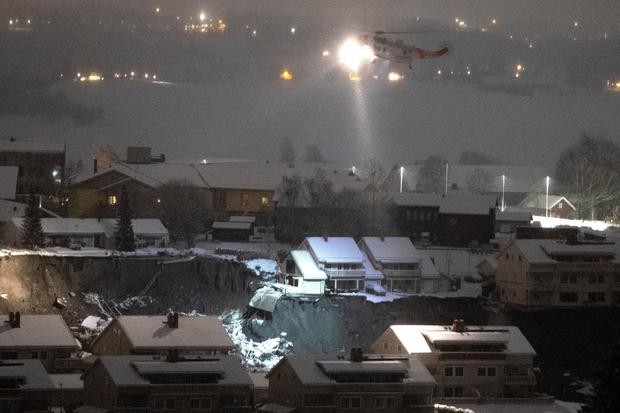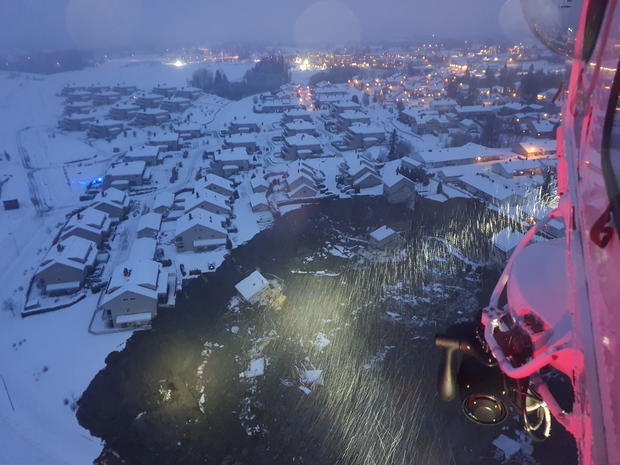Rescuers used helicopters, drones and dogs on Thursday to examine unstable terrain the day after a major landslide destroyed houses in a village near the Norwegian capital of Oslo. At least 10 people are still missing and another 10 were injured, local officials said.
An entire slope collapsed on Wednesday night in Ask, in the municipality of Gjerdrum, 15 miles northeast of the capital. Houses were destroyed and buried in dense, dark clay that was still too unstable on Thursday for rescuers to access on foot, the Reuters news agency reported.
TERJE BENDIKSBY / NTB / AFP / Getty
Subzero temperatures and snowfall made efforts to shore up the remaining structures and find what was missing even more challenging, with some houses dangling from the edge of the crater created by the landslide. Several buildings fell to the edge on Wednesday.
Norway’s Prime Minister Erna Solberg, who traveled to the village of about 1,000 people on Wednesday, described the landslide as “one of the largest” the country has ever seen.
“It is a dramatic experience to be here,” Solberg told reporters, expressing special concern for those who are still missing.
“The situation is still so unstable with the mud that nothing can be done but helicopter rescues,” he added.
NTB SCANPIX via Reuters
Norwegian media said 700 people had been evacuated from their homes, and the municipality warned that up to 1,500 might need to leave the region for security reasons.
“We are still looking for survivors,” said Reuters quoting local police chief Roger Pettersen, adding that children and adults are among those still missing.
Police said 10 people were injured, one of whom was transferred to Oslo with serious injuries.
Pettersen said on Wednesday that emergency calls came from people saying their homes were moving with them. Helicopters overnight used heat scanning technology to search for people and lowered several rescuers over the structures as part of their efforts.
“There are dramatic reports and the situation is serious,” said Pettersen.
According to the Norwegian Directorate of Water Resources and Energy (NVE), what happened was a so-called “rapid clay slide” of approximately 328 to 766 yards.
“This is the biggest landslide in recent times in Norway, considering the number of houses involved and the number of homeless,” NVE spokeswoman Laila Hoivik told AFP.
Fast clay is a type of clay found in Norway and Sweden that can collapse and turn into fluid when under stress.
“The area was previously researched and is known to contain fast clay. The possibility of similar large landslides in the area is low at the moment,” said Hoivik.
Reuters quoted Norwegian broadcaster TV2 as saying that a 2005 geological survey detected the clay and found the area unsuitable for residential development, but that new houses were built on the land just a few years later.
Norwegian king Harald said in a rare public statement that the accident “left a deep impression” on him.
“My thoughts are with all those affected, the injured, those who have lost their homes and now live in fear and uncertainty about the full extent of the disaster,” he said.


